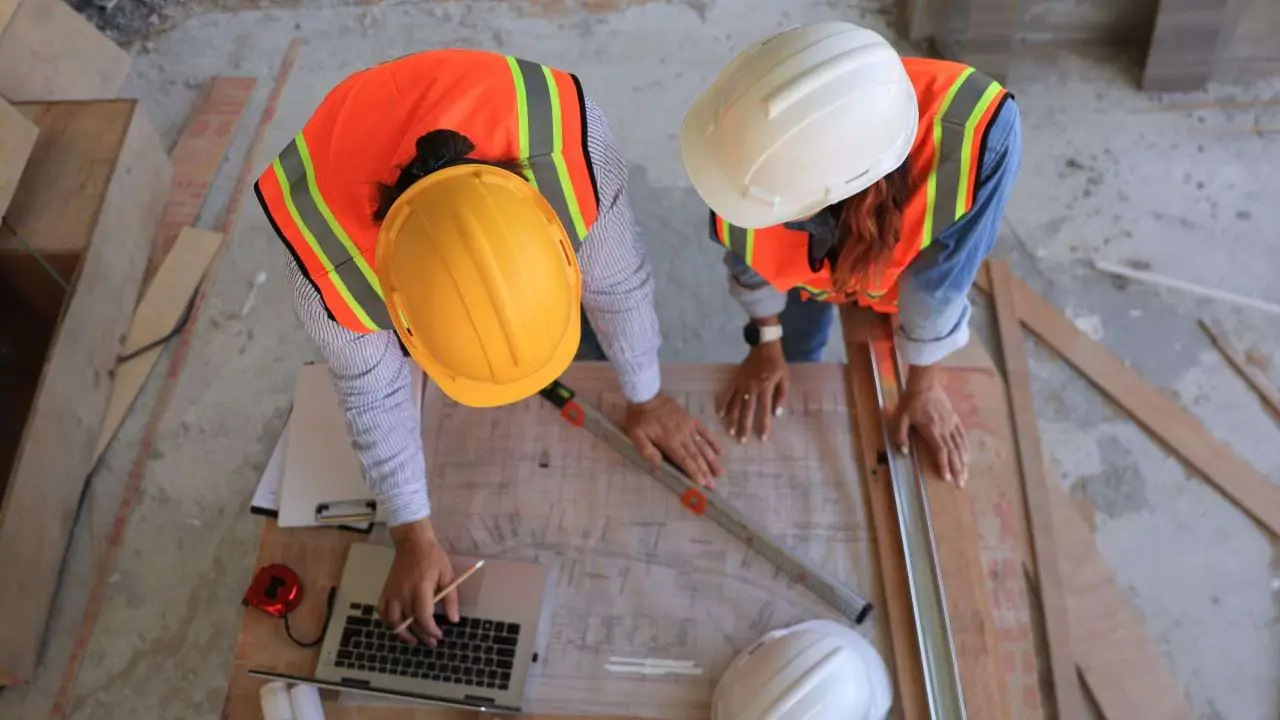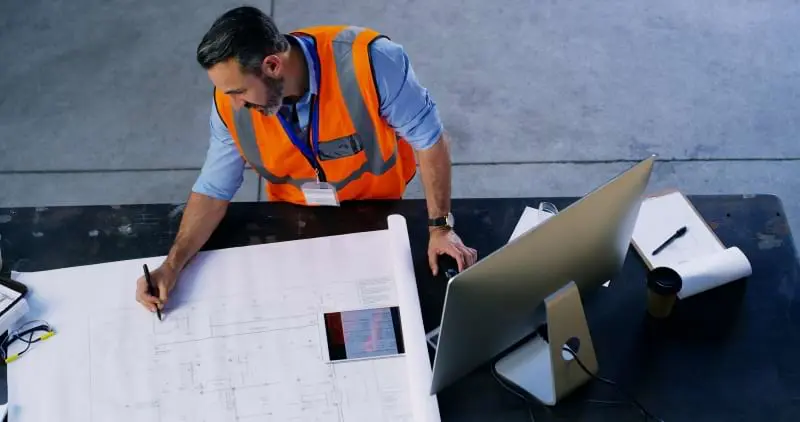The construction life cycle is the structured series of stages a project follows from inception to completion. It typically includes five stages: initiation, planning, execution, performance monitoring, and project closure. Each stage has specific objectives and tasks that guide the project toward success.
Understanding the life cycle is crucial because it offers:
- Enhanced Organization: A clear framework ensures tasks are completed in order, reducing chaos and confusion.
- Improved Communication: Defined stages keep stakeholders aligned on goals and progress.
- Efficient Resource Management: Streamlined processes eliminate waste and help projects stay on budget and schedule.
- Risk Reduction: Early problem-solving and risk identification minimize setbacks.
- Better Outcomes: A structured approach boosts the chances of meeting objectives and quality standards.
Read on to explore each stage in detail, the key stakeholders involved, common pitfalls to avoid, and tips for project success.
Table of Contents
Construction Life Cycle: A Quick Overview

The construction project life cycle encompasses five key stages: initiation, planning, execution, performance monitoring, and project closure, each crucial for a successful project from conception to completion.
Initiation (Pre-Construction)
This stage focuses on establishing the project’s viability and laying the groundwork for success. It involves feasibility studies, site selection, budgeting, and obtaining necessary permits and approvals.
During this stage, stakeholders define the project’s objectives and key deliverables, ensuring alignment on goals before moving forward. Early risk assessments are conducted to anticipate challenges that could impact feasibility. For proven front-end planning best practices, see the CII Front End Planning Handbook.
Planning
This stage involves creating a comprehensive plan for the project, including detailed designs, construction schedules, and resource allocation.
Planners also identify procurement strategies, set quality standards, and develop contingency plans to address potential risks. A well-structured planning stage ensures all parties are synchronized and ready for efficient execution.
Read too: Explore our Workplace Risk Assessment Templates
Execution (Construction)
This is the hands-on stage where the actual building takes place, requiring effective team management, resource coordination, and adherence to the approved plans.
Constant communication and on-site problem solving are critical to addressing unforeseen issues quickly. Safety protocols and quality control measures are rigorously enforced to maintain standards and protect workers.
Performance Monitoring
This stage involves continuously tracking the project’s progress, timeline, and budget to ensure it stays on track and potential issues are identified.
Regular site inspections, stakeholder meetings, and the use of project management software help maintain transparency and accountability. Proactive monitoring can significantly reduce costly delays and rework.
Project Closure
This final stage ensures builders address all remaining issues and project deliverables are completed and handed over to the client, formally concluding the project.
A thorough review or post-project evaluation is often conducted to document lessons learned and best practices for future projects. Final financial reconciliation and warranty documentation are also completed at this stage.
Why it Matters: Aligning Life Cycle Knowledge with Project Success

A strong understanding of each stage of the construction project life cycle is critical to reducing risks and ensuring success; following international standards such as ISO 21500:2012.
Thoroughly addressing each stage’s tasks and objectives helps teams anticipate and solve problems before they escalate.
For example, feasibility studies and early risk assessments during initiation allow decision-makers to evaluate project viability and avoid costly mistakes. Identifying site challenges, permitting issues, or budgeting constraints upfront lays a realistic foundation and lowers the risk of delays.
Clear, strategic planning is equally essential for controlling costs. A comprehensive plan creates a financial blueprint that guides execution, allocates resources efficiently, and includes contingency measures. Consistent performance monitoring throughout construction helps catch and correct cost overruns early, maintaining financial discipline.
Most importantly, following the full project life cycle fosters better stakeholder alignment. Each stage provides structured opportunities for communication, feedback, and consensus-building, minimizing misunderstandings and ensuring that everyone—from investors to contractors—works toward the same goals.
Deep Dive: The Five Core Stages of the Construction Project Life Cycle

Stage 1: Initiation (Pre-construction)
This is arguably the most critical stage of the construction project life cycle because it establishes the foundation on which the entire project is built. Meticulous attention to detail at this stage helps ensure the project’s viability, financial soundness, and overall success. This stage encompasses several essential activities, including site selection, feasibility studies, preliminary budgeting, and securing necessary permits and approvals.
Site Selection
Choosing the right location involves evaluating a range of factors, such as zoning laws, accessibility, soil conditions, environmental impact, and proximity to necessary utilities and infrastructure. The goal is to find a site that supports the project’s functional requirements while minimizing potential risks and costs.
Feasibility Studies
A feasibility study assesses whether the project is practically and financially achievable. This study examines technical considerations, environmental conditions, market demand, legal restrictions, and overall economic viability. Engineers, architects, financial analysts, and environmental consultants often collaborate to provide a comprehensive evaluation. By identifying obstacles early—such as unfavorable soil conditions, regulatory hurdles, or insufficient market support—teams can make informed decisions about whether to proceed, modify, or abandon the project before significant resources are invested.
Preliminary Budgeting
At this stage, cost estimators develop a rough financial plan covering land acquisition, design, construction, permits, labor, materials, and contingency reserves. Early estimates help stakeholders determine whether the project is financially viable. Establishing a solid preliminary budget also supports transparent discussions with investors and financing institutions, ensuring that financial risks are acknowledged and managed from the outset.
Permits and Approvals
This stage ensures the project complies with local building codes, zoning ordinances, environmental regulations, and other legal requirements. It often involves submitting detailed plans to government agencies, conducting public hearings, and addressing any conditions imposed by regulatory bodies. Delays in permitting can significantly disrupt timelines and budgets, so proactive management of the approval process is essential.
The pre-construction stage lays the groundwork for everything that follows. A strong start minimizes risks, controls future costs, and creates a shared understanding among all stakeholders about the project’s objectives, constraints, and opportunities.
By investing time and resources into thorough site evaluation, feasibility analysis, careful budgeting, and diligent regulatory compliance, project teams set themselves up for smoother execution, fewer surprises, and a higher likelihood of achieving their desired outcomes on time and within budget.
Stage 2: Planning
After a strong foundation is laid during pre-construction, the planning stage organizes all project elements—scope, schedules, cost estimates, designs, and procurement needs—into a clear plan that guides every subsequent action. Thorough planning significantly reduces the risk of delays, budget overruns, and miscommunication, ensuring that the project can move forward with confidence and precision.
Defining Scope
Scoping outlines the specific goals, deliverables, tasks, and boundaries of the project. It sets expectations by specifying what is included and, just as importantly, what is excluded. A well-documented scope serves as a critical reference point throughout the project, helping to manage stakeholder expectations and prevent “scope creep”—the gradual expansion of project requirements that can derail timelines and budgets.
Establishing Timelines
Project managers break down the overall project into smaller tasks and milestones, estimating the duration and dependencies of each. Tools like Gantt charts are often used to visualize the project schedule, showing task sequences, durations, overlaps, and critical paths. Other frameworks, such as the Critical Path Method (CPM) or Program Evaluation and Review Technique (PERT), are also applied to optimize scheduling and highlight activities that directly impact the project’s completion date.
Creating Cost Estimates
Building on preliminary budgets, estimators now calculate more precise costs for labor, materials, equipment, subcontractors, and administrative expenses. Contingency funds are included to cover unforeseen issues. Reliable cost estimates are crucial for financial planning, securing funding, and setting realistic expectations. Cost control measures are established at this stage to ensure that spending is tracked and managed throughout the project.
Developing Designs
Architects, engineers, and designers collaborate to create construction documents that define structural, mechanical, electrical, and plumbing systems, as well as aesthetic elements. These documents must be thorough enough to guide construction teams and support permit applications. Value engineering may also be employed—analyzing designs for cost-saving opportunities without compromising quality or functionality. Learn more about advanced civil engineering methods in ASCE technical publications.
Identifying Procurement Needs
The planning stage also maps out the project’s procurement strategy, identifying what materials, services, and equipment are needed, when they are needed, and how they will be acquired. Early procurement planning helps avoid supply chain delays and ensures that the right resources are available at the right time. Contracts are prepared for vendors and subcontractors, often using competitive bidding processes to achieve the best value.
The planning stage ensures no aspect of the project is left to chance. By clearly defining the scope, setting realistic timelines, finalizing cost estimates, developing detailed designs, and organizing procurement activities, the project team creates a comprehensive roadmap for success.
Stage 3: Execution (Construction Stage)
This is where all the planning, budgeting, designing, and coordination efforts materialize into physical progress on the site. Successful execution requires seamless coordination between contractors, effective labor management, careful handling of materials, rigorous safety measures, and the ability to adapt to on-the-ground realities that inevitably arise.
Contractor Coordination
The general contractor oversees the entire construction site, ensuring that all parties—including specialty subcontractors for electrical, plumbing, mechanical, and structural work—are working according to the approved project plans and schedule. Effective communication between contractors is crucial to prevent scheduling conflicts, duplication of work, or delays. Regular coordination meetings, clear reporting structures, and adherence to the project timeline keep all teams aligned and productive.
Labor Management
Project managers ensure that workers are trained, tasks are assigned appropriately, and labor resources are sufficient to meet schedule demands. Additionally, efficient labor management involves resolving disputes, handling personnel issues, and adjusting crew sizes based on project stages to maintain workflow without excessive downtime or overcrowding on-site.
Material Handling and Logistics
Project teams monitor inventory levels, manage storage logistics, and coordinate just-in-time deliveries to prevent materials from becoming damaged or taking up excessive space. Material submittals and approvals, where samples and specifications are reviewed before installation, are critical to ensuring quality standards are met before materials are used on-site.
Implementing Safety Measures
Project teams establish safety plans that include site-specific protocols, personal protective equipment (PPE) requirements, emergency response plans, and regular safety audits. Ongoing safety training and clear signage reinforce a culture of vigilance, minimizing the risk of accidents, injuries, and costly legal liabilities. All measures follow OSHA 29 CFR 1926 construction regulations to protect workers.
Learn more: Read our Ultimate Guide to Workplace Safety Tips
Adapting to On-Site Realities
Weather conditions, unforeseen ground conditions, supply chain disruptions, or design inconsistencies can arise during construction. Field teams must be empowered to make real-time decisions to adjust workflows, re-sequence tasks, or propose changes to designs (via Requests for Information [RFIs] or change order processes). A successful project team remains agile, constantly monitoring progress, assessing risks, and collaborating to find solutions that keep the project moving forward without compromising quality or safety.
The execution stage is where the vision becomes tangible. Every decision, adjustment, and action on-site directly impact the final outcome, making active management and proactive communication critical. Well-coordinated contractors, efficient labor management, careful material handling, rigorous safety enforcement, and adaptive problem-solving ensure that the project advances steadily toward completion—on time, within budget, and at the expected level of quality.
Stage 4: Performance Monitoring and Control
This stage is a continuous process that runs parallel to the construction activities, ensuring that the project stays aligned with its original plan. Careful monitoring of key metrics such as budgets, timelines, and quality standards helps teams identify issues early, make informed decisions, and keep the project moving toward successful completion.
Tracking Key Performance Indicators (KPIs)
Monitoring KPIs provides objective measurements of project health. Common KPIs include schedule adherence, budget variance, labor productivity, equipment utilization, safety incident rates, and quality compliance. By regularly evaluating these metrics, project managers can quickly spot trends or anomalies that signal underlying problems.
Monitoring Budgets
Financial tracking involves comparing actual expenditures against the planned budget on a frequent basis. Variance reports highlight discrepancies that may require immediate action, such as cost-cutting measures, change order reviews, or budget reallocations. Cash flow forecasts are updated regularly to ensure that funds are available when needed, avoiding disruptions caused by financial shortfalls. Early identification of budget issues prevents minor overruns from escalating into major financial problems.
Managing Timelines
Construction schedules, typically laid out in Gantt charts or critical path diagrams, are updated in real-time to reflect completed tasks, delays, or re-sequenced activities. Slippage reports identify tasks that are behind schedule, allowing project managers to allocate additional resources, work overtime, or modify task dependencies to recover lost time. Monitoring milestones and deliverables ensures that the project stays aligned with contractual obligations and client expectations.
Using Real-Time Project Management Software
Modern construction projects rely heavily on project management software for real-time performance tracking and collaboration. Tools like Procore and Autodesk Construction Cloud offer centralized platforms where teams can upload progress photos, update schedules, log daily reports, track financials, and manage RFIs and submittals. These systems provide dashboards and automatic notifications, giving project managers immediate visibility into every aspect of the project. Real-time data allows for quicker adjustments, streamlined communication, and improved decision-making, reducing delays and improving outcomes.
Stage 5: Closure and Handover
The project closure stage ensures that all project deliverables are completed, quality standards are met, and the client formally accepts the work. Closure involves a series of inspections, administrative tasks, legal formalities, and client handover processes. A well-executed closure stage not only finalizes the project but also lays the groundwork for future relationships, maintenance, and potential warranty service.
Final Inspections
Final inspections verify the work meets all building codes, regulatory requirements, and the specifications agreed upon in the contract. Inspectors assess critical elements such as structural integrity, electrical systems, plumbing, HVAC systems, safety features, and accessibility compliance. If deficiencies are found, they must be corrected promptly to achieve final approval. Third-party inspections or owner’s representatives may also be involved to validate quality independently.
Punch Lists
A punch list is a document created near the end of a project outlining minor tasks, corrections, or incomplete work that must be addressed before final acceptance. These items could include cosmetic flaws, missing hardware, touch-up painting, incomplete documentation, or minor adjustments to systems. The contractor, subcontractors, and client typically walk the site together to generate the punch list. Closing out the punch list completely is essential before substantial completion is declared and ownership officially transfers.
Legal Sign-Offs
Legal approvals and sign-offs include securing the Certificate of Occupancy (CO) or other jurisdictional approvals that legally certify the building is safe and ready for its intended use. Contractors must also complete any contractual obligations, such as lien waivers, compliance certifications, and closeout reports. Fulfilling these requirements protects both the contractor and the client from future disputes and ensures all parties have met their legal responsibilities.
Client Acceptance
Finally, the project moves to client acceptance. This formal handover involves presenting the client with keys, operational manuals, warranties, and as-built drawings (accurate records of the final construction versus the original design). At this point, final payments are typically issued, and contractual obligations conclude—except for any ongoing warranty obligations.
Project Documentation and Archiving
Complete project documentation is vital for both the client and the contractor. This includes all contracts, permits, drawings, inspection reports, equipment warranties, maintenance schedules, change orders, financial records, and correspondence. Archiving this information properly supports future facility management, troubleshooting, and potential expansions or renovations.
Warranty Stage and Post-Construction Follow-Up
Most construction contracts include a warranty stage or post-construction services period, typically lasting 12–24 months after project completion. During this time, the contractor remains responsible for repairing defects in workmanship or materials that arise under normal use. Warranty management involves periodic follow-ups, maintenance support, and prompt resolution of any issues reported by the client. A proactive warranty program demonstrates a contractor’s commitment to quality and can lead to stronger client relationships and repeat business.
Properly closing out a construction project validates that the project has been delivered according to the agreed-upon scope, meets all regulatory standards, and satisfies the client’s requirements. A thorough closure process brings the project to a professional and satisfying conclusion—marking not just the end of construction, but the beginning of the structure’s life cycle in use.
Other Stages That May Be Included
While the standard construction project life cycle covers initiation, planning, execution, monitoring, and closure, some projects benefit from additional specialized stages. These supplementary stages enhance project control, quality, and long-term performance.
- Design Stage: During this stage, architects and engineers develop conceptual designs, schematics, and construction drawings that refine the project’s vision. Detailed engineering, permitting documents, and early cost estimation also occur here, ensuring the project is well-defined before final planning begins.
- Procurement Stage: During procurement, bids are solicited, contracts are negotiated, and purchase orders are issued. Effective procurement ensures the timely and cost-effective sourcing of critical resources, minimizing potential delays during construction.
- Post-Construction Stage: Activities during this stage include warranty service management, facility maintenance training, periodic inspections, and assisting the client with occupancy issues. Strong post-construction services strengthen client satisfaction and can lead to repeat business or future project opportunities.
Stakeholders Involved in Each Stage
Initiation (Pre-Construction)
- Client: Define project goals, secure funding, select site.
- Architect: Assist with site evaluation and create preliminary designs.
- Contractor: Provide constructability input if consulted early.
- Site Engineer: Conduct site surveys and geotechnical investigations.
- Regulatory Bodies: Review initial site plans and issue preliminary approvals.
Planning
- Client: Approve designs, set budget constraints, and review project schedules.
- Architect: Develop detailed drawings, specifications, and construction documents.
- Contractor: Provide cost estimates and assist with constructability input.
- Site Engineer: Verify technical feasibility and contribute to planning decisions.
- Regulatory Bodies: Approve detailed plans and issue construction permits.
Execution (Construction)
- Client: Monitor progress, approve major changes, and fund ongoing construction.
- Architect: Conduct site visits, clarify design intents, and respond to RFIs.
- Contractor: Manage labor, materials, subcontractors, site safety, and construction schedule.
- Site Engineer: Supervise construction quality and inspect ongoing work.
- Regulatory Bodies: Conduct periodic site inspections and enforce compliance with codes and standards.
Performance Monitoring
- Client: Review progress reports and participate in milestone reviews.
- Architect: Address design clarifications and issue necessary modifications.
- Contractor: Submit progress updates, track KPIs, monitor budget performance, and adjust schedules.
- Site Engineer: Monitor technical quality, safety adherence, and project timeline.
- Regulatory Bodies: Inspect the site for compliance and issue corrective actions if necessary.
Closure
- Client: Perform final inspections, formally accept the project, and complete final payments.
- Architect: Complete as-built drawings, assist with punch list completion.
- Contractor: Complete punch list items, finalize project documentation, and facilitate warranty handover.
- Site Engineer: Validate final construction quality and assist in the handover process.
- Regulatory Bodies: Issue final occupancy certificates and other necessary legal documents.
Common Pitfalls and How to Avoid Them
Skipping Feasibility Studies
- Mistake: Rushing into planning without confirming if the project is viable.
- How to Avoid: Conduct thorough site analyses, market research, and technical assessments before committing resources.
Unclear Project Scope
- Mistake: Vague or incomplete scope leads to confusion, changes, and disputes.
- How to Avoid: Define and document a detailed scope early and stick to it unless formal changes are approved.
Inadequate Budgeting
- Mistake: Underestimating costs or ignoring contingency needs.
- How to Avoid: Develop a realistic budget with input from estimators and always include a contingency reserve.
Poor Scheduling
- Mistake: Unrealistic timelines or missing task dependencies cause delays.
- How to Avoid: Build detailed schedules using Gantt charts or CPM methods and update them regularly.
Poor Closeout Documentation
- Mistake: Missing manuals, warranties, and as-built drawings delay handover and cause disputes.
- How to Avoid: Start collecting and organizing closeout documents early and use checklists to ensure completeness.
Take the Next Step with Acuity’s Construction Expertise

At Acuity International, we specialize in delivering comprehensive Program & Construction Management solutions that guide your projects from concept to completion. With decades of experience managing complex projects across industries, we understand every stage of the construction life cycle—and we know how to keep your project on time, on budget, and aligned with your goals.Explore our Program & Construction Management solutions today and discover how we can help you build smarter and stronger. Contact us to learn more.
